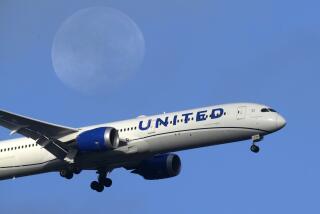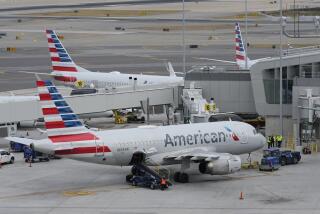The frequent-flier mantra: Maximize those award miles
- Share via
If your frequent-flier mileage account looks healthy, it may be because airline frequent-flier programs are doling out record numbers of miles.
Book your next ticket on most airlines’ Web sites and get a 1,000-mile bonus. Obtain certain credit cards and get a 15,000-mile bonus, which is more than half of what you’ll need for a free coach ticket on a domestic flight on many carriers. Refinance your house with some lenders and rack up even more miles.
“Over 8 trillion miles are now sitting in members’ accounts around the world,” says Randy Petersen, publisher of InsideFlyer, the monthly magazine for frequent fliers.
But don’t start packing your bags for Hawaii just yet.
Frequent-flier programs, designed to encourage customer loyalty, are one of the most successful marketing programs ever created. They have more than 120 million members worldwide who have used millions of free and upgraded tickets. Indeed, some would argue that the flier programs are too successful. As a result, several airlines are boosting the cost of some awards.
Among the changes:
* On May 1, American Airlines raised the mileage requirements on a half-dozen of its favorite awards by as much as 25%. The capacity-controlled (that is, only so many award seats on each flight) PlanAAhead round-trip domestic business-class ticket now costs 45,000 miles, up from 40,000. The AAnytime (which has no restrictions) round-trip domestic coach ticket now costs 50,000 miles, an increase of 10,000.
* On June 4, Continental and Northwest will raise the mileage requirements for their capacity-controlled business-class tickets between North America and Hawaii from 60,000 to 75,000 miles.
* On July 1, British Airways, which has 2 million U.S. members, will increase the mileage requirement for a round-trip business-class ticket between North America and London from 80,000 to 100,000 miles and for a first-class ticket from 100,000 to 150,000 miles.
The devaluation of your hard-earned miles also is occurring in other, more subtle ways. Many carriers, for example, no longer allow their members to use miles to upgrade from coach to business class on domestic and, particularly, international flights if they buy one of the heavily advertised coach fares.
This new restriction is a particular blow because one-class international upgrades are one of the better uses of miles. Frequent fliers can spend 50,000 miles to upgrade a $600 to $800 coach ticket to a comfortable business-class seat that would have cost 10 times the coach fare if you had to pay for it. But don’t expect to upgrade the super-cheapie $300 and $400 seats purchased on the Internet.
The devaluation is a matter of supply and demand: Too many miles are chasing too few frequent-flier awards. The airlines use sophisticated computer programs to figure out which seats on which flights will remain unsold, and those are the seats they allocate to mileage redemption awards.
But the airlines don’t have enough of those seats to meet demand on many flights.
Just look at the numbers. Besides the 8 trillion miles in their accounts, members also are accumulating an estimated 500 billion additional miles each year. If members could claim every free ticket or upgrade they wanted, many planes would be filled with passengers flying free, and the carriers would face even greater financial challenges.
The problem is compounded by the fact that most carriers have reduced their flight schedules -- up to 20% in some cases -- since 9/11, so they have fewer seats to give away. Or they are flying smaller planes, which also translates to fewer seats for paid tickets and awards.
Here’s how travelers can minimize the effects of mileage devaluation:
* Read your program’s newsletter carefully. “The airlines don’t hide the notices of mileage requirement increases,” says Petersen of InsideFlyer. “You’ve just got to take the time to find them and read them.”
* If you know a mileage requirement increase is coming and you’ve saved up the miles for a dream ticket, claim the award now, because it may be good for as much as a year. Or book your ticket now. Many airlines accept bookings up to a year in advance. Once you have the award or the actual ticket, the mileage increase probably will not affect you.
* If you are a few thousand miles short of your prize, don’t worry. Some programs will allow you to go into “negative” balances -- that is, overdraw your account. Many will sell you miles (usually up to 10,000 to 15,000 miles a year); it will cost you several cents a mile.
Still others will allow you to transfer miles from one member’s account to another for a fee based on the number of miles transferred, usually several cents a mile.
If you have plenty of time to earn those extra miles, you can fall back on the old standbys: Get a credit card or change your long-distance telephone service for the frequent-flier mileage bonus. Just be sure that the necessary miles will be credited to your account in time to beat the mileage requirement increase.
* Be realistic about what you can and cannot get, says Matt Bennett, publisher of www.firstclassflyer.com, an electronic newsletter about business- and first-class air travel. “If you want four ... tickets to take the family to Orlando [Fla.] or Hawaii during a school vacation, you are competing with thousands of other frequent fliers who have exactly the same idea. Ditto for business- and first-class seats to Europe in summer.”
To avoid disappointment, “keep a range of dates in mind, not just a single one,” he says. “Select flights that depart earlier or later than you’d prefer, or take a connecting flight rather than a nonstop. If the carrier where you earned your miles cannot accommodate you, maybe one of the partners in its frequent-flier program can.”
Charles Lockwood is a Los Angeles-based writer and frequent flier. Travel Insider welcomes comments and suggestions but cannot respond individually to letters and calls. Write Travel Insider, Los Angeles Times, 202 W. 1st St., Los Angeles, CA 90012, or e-mail [email protected].
More to Read
Sign up for The Wild
We’ll help you find the best places to hike, bike and run, as well as the perfect silent spots for meditation and yoga.
You may occasionally receive promotional content from the Los Angeles Times.






